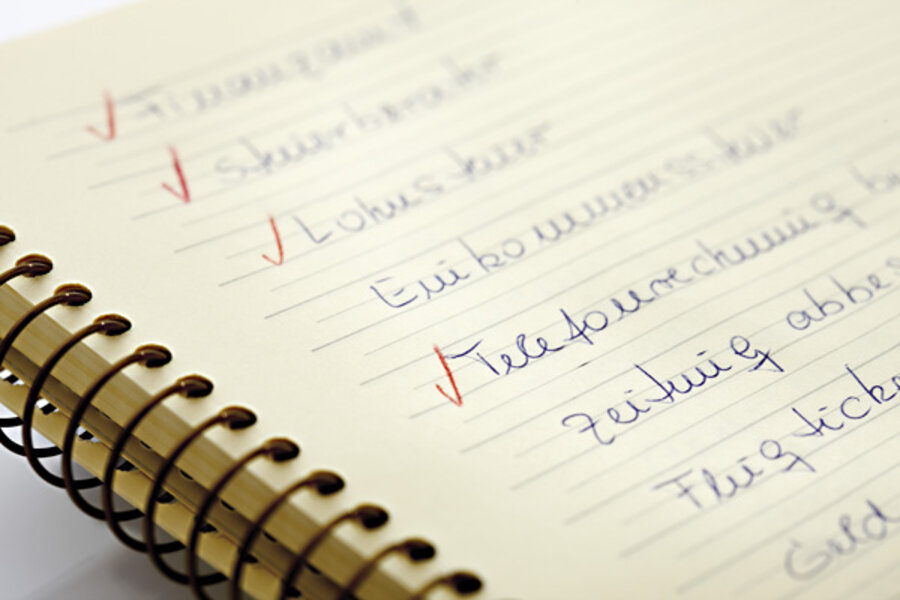Create a plan for your New Year's resolution
Loading...
Create a plan to achieve that resolution.
Yesterday, we discussed the usefulness of coming up with a single specific resolution for the coming year. A good resolution is one that offers a way to measure your progress, is very clear on whether or not success is achieved, isn’t based on unrealistic expectations, and is in line with something you deeply want in your life.
You have this resolution in place, but how do you really get there? The key to actually achieving a resolution is to have an actionable plan right from the get-go. Don’t just stumble into an audacious goal – know before day one what exactly you’ll need to do on day one to get there and what you’ll need to do on subsequent days as well.
Over the last few years, I’ve had great success in achieving my New Year’s resolutions thanks to simply applying four principles before I ever even start.
First, identify the precise day-by-day steps you need to take to achieve your resolution. In order to achieve the two resolutions I’ve discussed so far, I need to have an exercise session five times a week that lasts between an hour and an hour and a half. I also need to continue (and possibly expand a bit) my piano practice schedule. Within each of these sessions, I already have a plan in place that covers at least the first month of work. I know exactly what I’m going to do to achieve those goals, at least at the start.
What about after that? In each case, I have a teacher or trainer to turn to for feedback, ideas, suggestions, and future directions. This will make it very easy to make specific plans for future sessions after the first month.
For you, I suggest coming up with a specific daily plan for your first month towards the goal, as well as some mechanism for reviewing your progress and coming up with plans after that. How you choose to do that is up to you.
Second, keep a diary of your progress. For years, I’ve kept an electronic diary in which I journal such things. This year, I’ve decided to actually move back to a pocket paper diary, a small Moleskine daily diary that my wife got me as a Christmas gift.
In either case, one consistent element of these entries is to simply note how I moved forward on the important things in my life that I’m really focused on. Did I exercise? Did I play the piano? Did I read? Did I spend valuable time with my wife, my children, or my friends? Did I learn something new? These daily entries help me to keep stock of what I’m doing and whether I’m moving forward on the important things.
Later on, when I look back at such entries, I have a great grasp as to how my life was going then. What was important to me? What progress was I making on those things? What was I thinking about? I get a great sense of how I’ve grown and changed since then and it helps me to realize how effective my goals have actually been in terms of improving my life.
Third, plan how you’re going to come up with any additional time needed for the goal. For example, for my final New Year’s resolution, I’m going to need to scavenge a bit of regular time from some other activities in my life. This involves taking a look at my life and figuring out what activities I’m willing to give up in exchange for this goal. I’ve chosen to give up online computer games for that goal, which actually adds almost the perfect amount of time to make that goal happen.
How much additional time will you need in an average week to pull off that resolution? Where will that time come from? Figure out now where you’ll get that time from so that you’re not stuck having to make hard choices later on which can easily drive you off the rails of your resolution.
Finally, write it down. Write down your resolution. Write down your plans for achieving it. Write down how your plans change over time. Write a statement about how you’re feeling at the start of it, then write another statement at each interval throughout it (like once a month). The more words you put down on paper with regards to your goal, the more concrete that goal becomes. It goes from being a vague idea in your head into something real and tangible, something that you don’t just walk away from because the ice cream is calling from the freezer or because you’d rather watch The Big Bang Theory.
Make a plan. Add the details. Write it down. Keep a journal. This is the structure you need to make this work and to really change your life.
Add/view comments on this post.
------------------------------
The Christian Science Monitor has assembled a diverse group of the best economy-related bloggers out there. Our guest bloggers are not employed or directed by the Monitor and the views expressed are the bloggers' own, as is responsibility for the content of their blogs. To contact us about a blogger, click here. To add or view a comment on a guest blog, please go to the blogger's own site by clicking on the link above.





